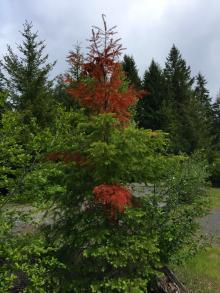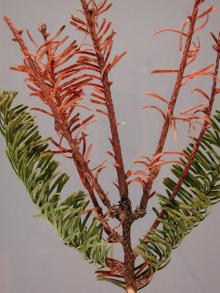Cause Many conifers are susceptible to drought stress especially noble fir, grand fir, Pacific silver fir, subalpine fir, Alaska yellow cedar, Engelman spruce, Sitka spruce, western red cedar, and western hemlock. Douglas-fir and incense cedar are more tolerant of drought than noble or grand fir but can have similar problems on lower elevation, south-facing or marginal sites. Newly planted trees are most at risk to drought damage. Drought-stressed trees are highly susceptible to secondary attack from insects and canker-causing fungi. Loss of older needles may be a survival mechanism to reduce moisture loss. Drought damage can accumulate over several years of subnormal precipitation and persist after normal conditions return. During extreme warm, dry weather, trees may not regenerate rootlets fast enough to replace those lost to moisture stress. The degenerating root system results in crown decline, which in turn reduces food supply to roots. This process is known as carbon starvation. Hydraulic failure, where water loss from transpiration is greater than the uptake by roots, can also result in progressive cavitation and conductivity loss in the xylem. Similar symptoms occur from winter injury when soil becomes frozen and water is unavailable. This problem can be observed in the landscape and in potted nursery trees. In some potted plants, the root-shoot ratio is so lopsided that trees have a difficult time maintaining water levels.
Symptoms Drought injury usually progresses from the top of the tree downward and from the outside to the inside of the crown. Dieback at the top of the tree and/or tips of the branches, where water has the furthest to travel, is also common. Premature loss of needles at the mid-crown; base and tip of shoots can also occur in Douglas-fir. Older needles commonly turn yellow and are shed prematurely. Roots may still be alive even though the entire aboveground canopy appears to be dead but these trees will not survive.
Winter injury, gopher and root weevil problems can produce similar symptoms. The influence of drought on plant health can be very confusing. Many pathogens and insects respond to plant stress associated with drought, and it can be very difficult to discern which is truly responsible for the problem. Getting a proper identification of the pathogen or insect found on the plant allows the grower to determine if the pest is a drought opportunist or a primary host attacker.
Cultural control
- Maintain soil moisture through supplemental irrigation for landscape and potted trees. Trees require infrequent, slow and deep watering to allow water to penetrate soils and be taken up by roots.
- Plant drought tolerant species on soils more likely to produce drought problems such as thin, porus, or rocky soil.
- Grass, weed, and brush control will help get rid of competing vegetation and conserve existing water.
- Plant in the late fall or early spring to help establish root systems before annual summer and fall drought periods.
- Do not fertilize during droughts, fertilization increases growth and therefore water requirements.
- Mulching around the base of trees will help conserve water, suppresses weeds, improve soil quality, and enhance tree growth.
References Chastagner, G.A. 1997. Christmas Tree Diseases, Insects, and Disorders in the Pacific Northwest: Identification and Management. Washington State University Cooperative Extension. MISC0186.
Sevanto, S., McDowell, N.G., Dickman, L.T., Pangle, R., and Pockman, W.T. 2014. How do trees die? A test of the hydraulic failure and carbon starvation hypotheses. Plant, Cell & Environment 37:153-161.



